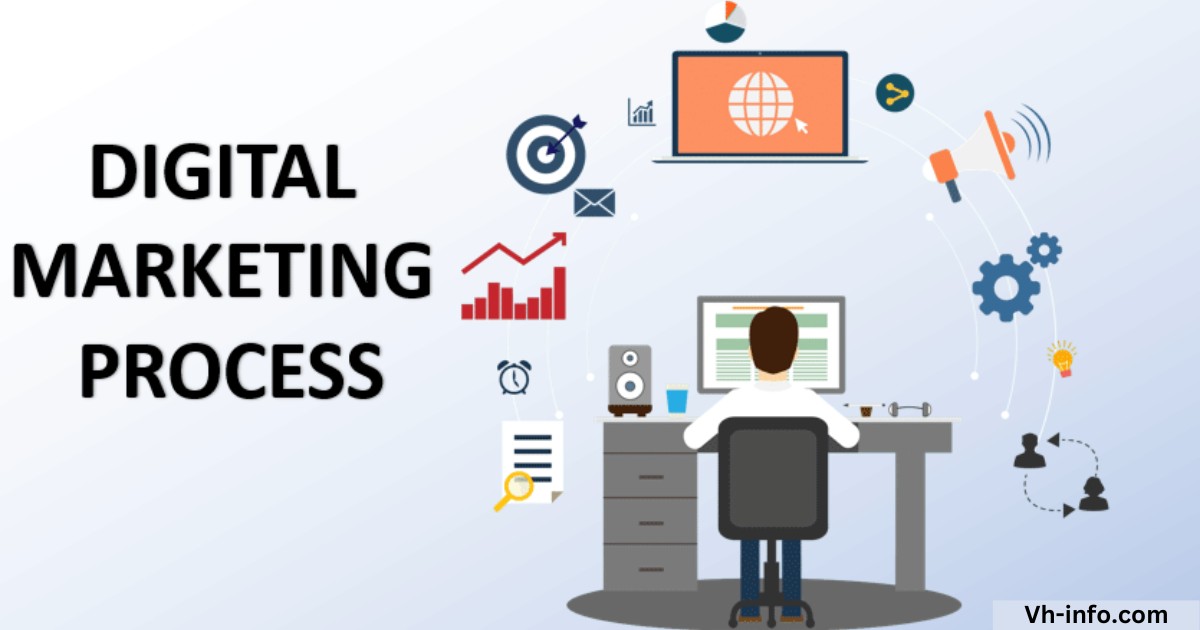In today’s digital world, having a strong digital marketing process is crucial for businesses to thrive.
If you’re wondering where to begin, look no further!
In this blog, we’ll guide you through every step of the digital marketing process, from initial research to optimization.
We’ll delve into various types of digital marketing like SEO, PPC, and social media marketing, explaining why a solid digital strategy matters for your business’s success.
We’ll explore whether this approach fits all businesses or not and share real-life success stories of impactful digital marketing campaigns.
As a link-building agency, VH-Info understands the significance of effective digital strategies. We’ll even provide insights into FAQs about digital marketing strategies.
So, let’s start this journey together!
What is the Digital Marketing Process?

Digital marketing, also known as online marketing, is like showcasing things online, such as products, services, or brands, to get attention, make sales, or spread the word. It involves using the internet and digital platforms to reach people in today’s digital landscape. The digital marketing process includes various strategies and techniques, including marketing techniques, used by digital marketers to meet business goals, like boosting sales or increasing brand awareness. It’s basically how businesses use online tools to connect with customers and achieve their marketing aims.
Digital Marketing Process Steps
Step 1: Research
The first thing in digital marketing is doing research, including keyword research. This means gathering info about the product, the people who might want it, and the market it’s in. We also look at other similar stuff out there.
This helps make a smart plan for advertising and standing out from others. The info we collect includes things like details about the business, who might be interested, what’s being sold, and what the competition is up to.
Identifying the target audience and understanding their pain points, including crafting detailed buyer personas, is imperative for every content strategy if you want users to find you on search engines.
Additionally, it is important to consider different options for marketing communications in the online marketplace, including video ads.
Step 2: Create
The next step in digital marketing is being creative. We take all the info we gathered earlier and use it to make a cool plan for advertising, including a ppc campaign. This plan focuses on goals we want to reach and things we want to achieve, including marketing goals.
We come up with ways to show off the brand and decide what kind of content strategy to use, including reaching new audiences. The main goal is to achieve your business objectives, whether it’s making more money or getting the attention of lots of customers, or maybe both!
Step 3: Promote
This is when the digital marketing teams begin showing off the products or services. They do this on lots of online places like search engines, social media, emails, and other websites where people buy things or see ads.
Step 4: Analyze
The last part of digital marketing is checking how everything went. They gather all the results from the campaigns and look at them closely to see if they made good money or not. This helps figure out what worked well and what didn’t, so they can make even better campaigns later. They use tools like Google Analytics, which is from Google, to analyze the performance of their landing page and other assets and channels using key performance indicators (KPIs).
Different Types of Digital Marketing Processes
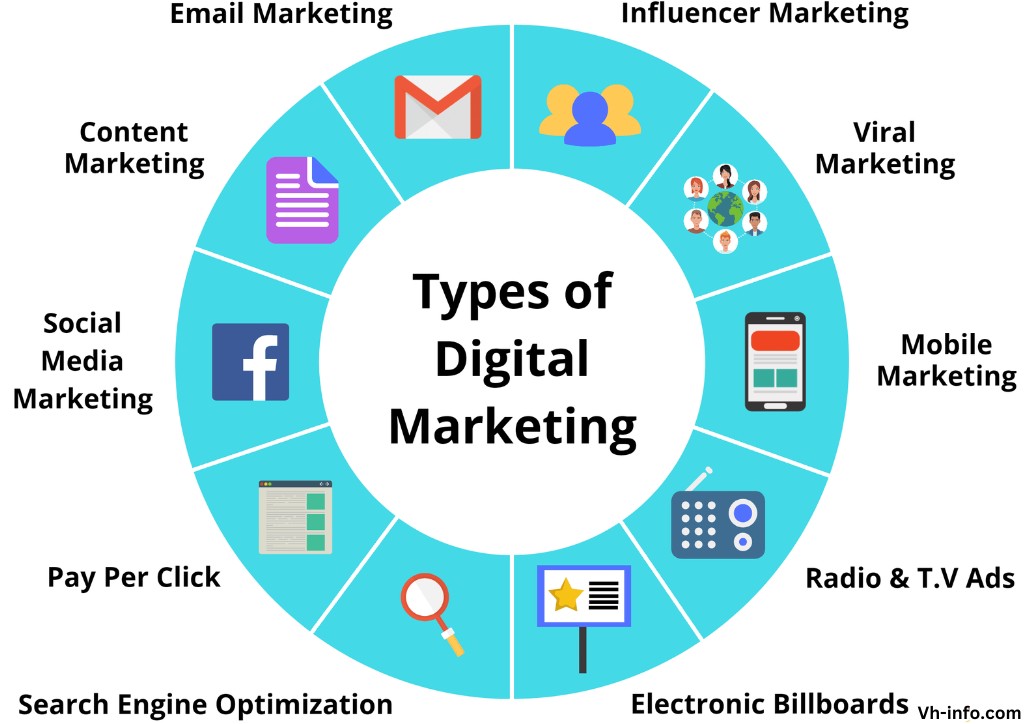
Now that we know what digital marketing is, let’s check out the different ways marketers use to show off, advertise, and sell their stuff.
E-Mail Marketing

Email marketing is when you send emails to people who might be interested in your stuff to tell them about your products or services.
But it’s not as simple as it sounds.
To start, you need to make sure your emails don’t end up in the spam folder. You do this by making a list of people who want to get your emails.
Here’s what you need to do to create an effective email marketing campaign:
- Personalize the content for each person in both the email body and the subject line.
- Clearly explain what kind of emails the person will get.
- Send different types of emails – some for promotions, some for transactions.
- Make it easy for people to unsubscribe if they want to stop getting your emails.
The goal is to make sure your customers see your emails as helpful, not just ads.
Email marketing is a great way to get leads. If you use marketing tools that automate tasks, it becomes even better. These tools help you organize and schedule your emails based on what your customers want, making things easier for you.
Marketing Automation
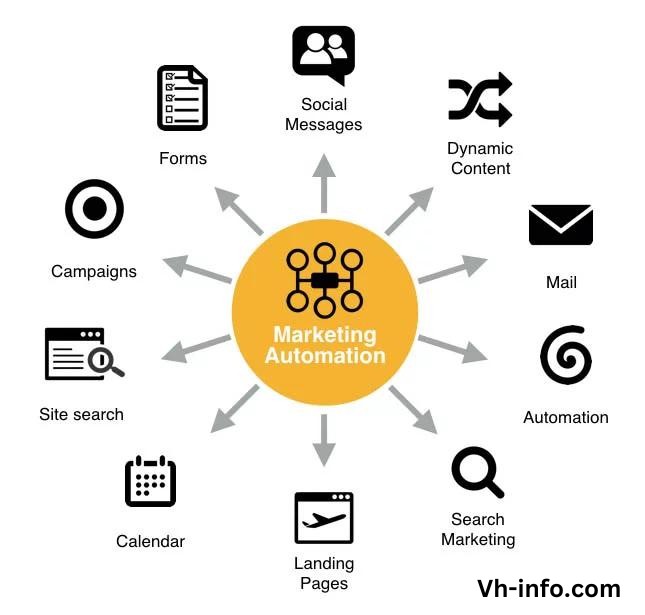
Marketing automation is a way of doing digital marketing smarter.
It uses special software to help with campaigns, making things work better and faster. This software gathers info about customers and uses it to plan specific campaigns. It uses special software for digital marketing to help with campaigns, making things work better and faster.
By studying this info, it sorts out and plans when to send marketing messages to the right people at the right time.
Search Engine Optimization (SEO)

Search Engine Optimization (SEO) is a digital way to make sure your website shows up higher when people search for things on search engines like Google, Bing, or others. It’s a big deal in digital marketing and can lead to good job opportunities.
To make your web pages rank better in search results, you need to focus on a few important things: have really good content, keep people interested in your site, make sure it works well on mobiles, and get good quality websites to link to yours. To make your web pages rank better in search results, you need to focus on a few important things: have really good content, keep people interested in your site, make sure it works well on mobiles, or, even better, create an app, and get good quality websites to link to yours.
Since Google changes how it ranks pages often, it’s important to keep up with these changes when planning your SEO strategy to increase the amount of organic search traffic to your site. Also, keep an eye on your web pages regularly and make changes if needed.
Content Marketing

Content marketing is a way to get people interested in things by sharing really good content. This content can be in different forms like written stuff such as blogs or articles, audio things like podcasts, or video content like vlogs shown on websites or online channels.
The key is to make content that’s original, fun, and interesting for the people who see it, so they like it and maybe tell others about it too. Implementing a content marketing strategy, including content creation, is crucial for businesses to effectively reach their target audience and engage them with valuable content, including social media posts that drive website traffic.
Search Engine Marketing (SEM)
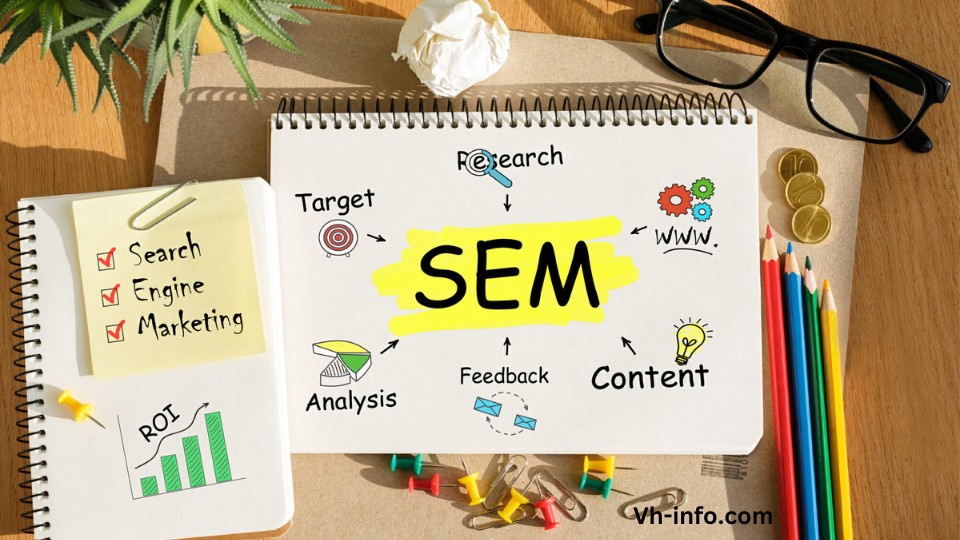
Search engine marketing is a way to get noticed more on search engines by paying for ads. People who want their stuff to show up when others search for specific words pay search engines to boost their visibility.
To make this work well, it’s important to have good ads, pick the right words related to what you’re selling, make sure the page people land on is good, and decide how much to pay for the words and ads you use.
Pay Per Click (PPC)
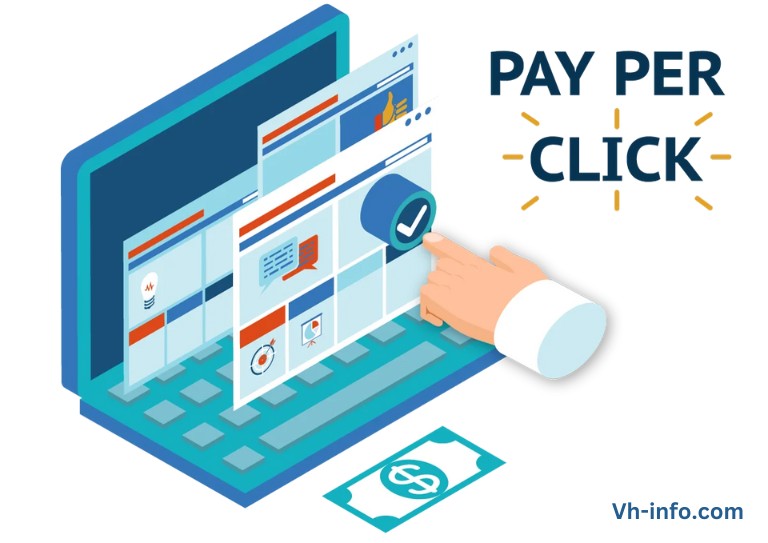
PPC marketing is a type of online advertising where companies pay whenever someone clicks on their ad and goes to their website. Usually, these ads are on Google and Microsoft Ads.
There are different kinds of campaigns within these platforms, depending on what the advertiser wants to achieve.
These can be:
- Ads that show up in searches.
- Ads that appear on websites.
- Ads specifically for shopping.
- Ads on YouTube.
- Ads for apps.
- Ads on Discover.
- Performance Max ads.
These ads can be aimed at specific groups of people or for everyone, based on what the company wants. Overall, PPC helps companies get more traffic, make more sales, and get more people to take action on their website.
Affiliate Marketing

Affiliate marketing is when you team up with a company, like an online store, to send people to their website or buy their stuff.
When people you send over make a purchase or just visit, you get a commission. You can do this by writing about their products on your site or by running ads that lead people to their product pages on search engines.
Influencer marketing, like affiliate marketing, relies on working with an influencer–an individual with a large following, such as a celebrity, industry expert, or content creator–in exchange for exposure.
In many cases, these influencers will endorse your products or services to their followers on several social media channels.
Instant Message Marketing
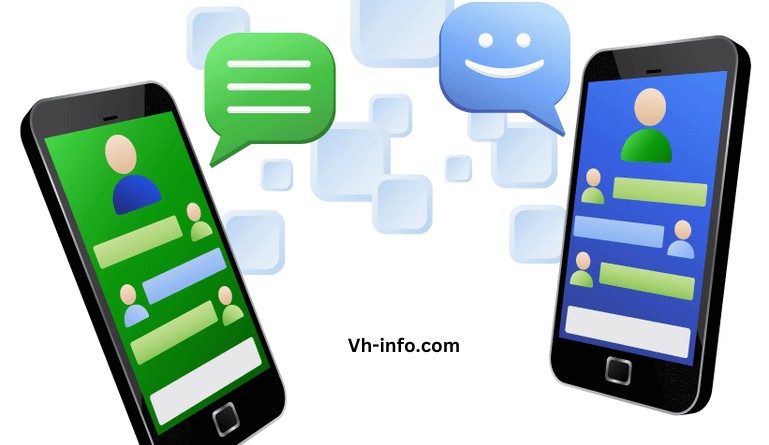
Instant message marketing is when companies use messaging apps to either advertise their products or give customers a good experience. Lots of businesses do this by using their official chat accounts and using automated tools or chatbots to talk with people.
Social Media Marketing (SMM)

Social media marketing means using social media sites, such as Facebook, YouTube, Twitter, Instagram, and other social platforms, to advertise and sell things.
It’s all about getting people interested in products and services by talking about them on these platforms. Social media presence also uses famous people on these sites to promote things to specific groups of people who follow them.
For example, an older celebrity might promote anti-aging products, while a younger influencer might show off trendy clothes.
Native Advertising

Native advertising is when ads blend in with entertaining content. The idea is to make the ad look interesting, so people don’t ignore it and actually watch or read it. But it’s important not to trick or annoy people.
The ad should say things like “sponsored” or “promoted” to show it’s an ad. It needs to be clear it’s an ad but also fun and interesting so people like it and feel good about the product without feeling like they’re just being sold something.
Mobile Marketing
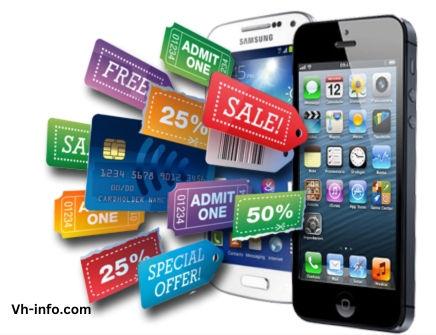
Mobile marketing refers to advertising and marketing efforts that target users on their smartphones and tablets. It involves customized messaging and content designed for the small screen, delivered through SMS (text messages) using a text length counter to ensure concise and effective campaigns, mobile apps, mobile sites, and mobile ads. The goal is to effectively promote brands, engage customers, and drive conversions on mobile devices.
Why having a Digital Marketing Process is important?

Here are a few key reasons why having a defined digital marketing process is important:
- It provides strategic direction – A documented process acts as a roadmap and guides your digital marketing efforts. It ensures you have clear goals and a plan to work towards them in a methodical way.
- Improves efficiency – A defined workflow means your team knows exactly what needs to be done, by whom, and when. This eliminates guesswork, confusion about responsibilities, and duplications of effort.
- Aids collaboration – Different digital marketing activities often involve multiple teams and stakeholders. A set process facilitates better communication and collaboration between them.
- Measures progress – Milestones and metrics built into the process help you track progress. You can monitor what stage a campaign is at and if goals are being achieved at each step.
- Identifies optimization areas – Analytics insights gained at each process stage can reveal issues and opportunities for optimization to improve future campaign performance.
- Institutionalizes expertise – Documenting the process captures the knowledge and expertise of top performers. This can help develop a mentorship program to train new hires and build organizational capability over time.
Does having a proper digital marketing process work for all businesses?
Digital marketing can help any kind of business, no matter what they sell. It’s about understanding who your customers are and making useful stuff online for them.
But it doesn’t mean every business should use digital marketing tactics, like social media, content marketing, and email marketing, in the exact same way.
Different businesses might need specific goals and strategies for a proper digital marketing plan and digital media marketing tactics to work best.
B2B Digital Marketing

If your business sells to other businesses (B2B), your digital marketing probably aims to get new leads online, leading to a chat with a salesperson. Your strategy might focus on bringing in the best possible leads for your sales team through your website and other online ways.
Apart from your website, you might spend more time on places like LinkedIn, where other businesses hang out online. That’s where you’re likely to find the people interested in what you offer.
B2C Digital Marketing

If your business sells directly to people (B2C), your digital marketing is probably about getting folks to visit your website and buy things without needing to talk to a salesperson.
You might not focus as much on traditional ‘leads‘ and instead aim to speed up how quickly someone goes from visiting your site to making a purchase. This might mean highlighting your product features early on and using more powerful messages to get people to buy.
B2C companies often find Instagram and Pinterest more helpful than LinkedIn because these platforms are where regular people spend more time online.
Digital Marketing Examples

Lego’s Rebuild the World Campaign
This digital marketing campaign by Lego is awesome because it shows what the brand stands for. Lego talks about important world problems in this campaign to connect with its audience.
These days, it’s more and more important for companies to talk about big world problems and show they care about the same things as their customers. This campaign is a big way for Lego to tell its story and message.
Because 82% of customers like buying from brands that care about the same things they do, this was a smart move for the toy company.
Dove’s Reverse Selfie Campaign
Dove wanted to talk about how social media affects young girls, so they did something cool.
Their Reverse Selfie campaign shows what a teenage girl does before taking a selfie and then how she changes the picture with editing. They did this to show how social media can make people feel bad about themselves.
This is a great example of marketing that really connects with its audience. Dove knows their audience well – they’re mostly real women, some of them parents. That’s why Dove could talk about something important that many people might not think about when using social media.
Jennifer Lopez’s #InTheMorningChallenge
In this social media thing, Jennifer Lopez made a dance challenge to tell people about her new song. Fans could do the dance in their pajamas or dressed up.
It worked really well! Lots of people watched the video more than 16 million times, and over 5,000 folks posted about it.
Using social media is a cool way to get people involved with your brand and make them a part of what you’re doing.
Always’ #DayoftheGirl Campaign
Here’s another digital campaign that focuses on feelings. Always, a brand, asked their own workers for advice they’d give to girls. These women shared their thoughts to inspire everyone for International Day of the Girl, which happens every October.
They didn’t talk a lot about their product in this campaign. Instead, the goal was to inspire people. By doing that, they reached more folks, made more people know about their brand, and showed that they care about the same things as their audience.
Now let’s check out different ways digital marketing works!
Topicals – Email Marketing
Topicals, a company that sells skincare stuff, uses email marketing in its digital plan. They sent an email (shown below) promoting a deal: if you subscribe, you get 20% off when you buy refills.
Ashley White – Affiliate Marketing
Ashley White is an esthetician who does affiliate marketing. On her Twitter profile, she has a Linktree page with links and codes for discounts. When people shop using her links, she gets credit or perks.
She presents herself as a supporter of these companies, which helps these brands get noticed. When someone checks out her Linktree, they might want to try a new brand. And if an influencer like Ashley recommends it, that suggestion can be even more convincing.
Samsonite – Search Engine Marketing
Search engine marketing is a cool part of digital marketing. Brands bid on words and show ads when someone looks up those words online.
The picture below shows an example from Samsonite. When someone searches for “luggage,” ads for different luggage options pop up from well-known brands. These brands made ads to show their products first when people search for luggage.
Yes Williamsburg – Sponsored Ad
Yes Williamsburg uses native advertising on its Instagram. They share a paid partnership with a local Brooklyn business. Even though it’s labeled as a paid partnership, it looks like a regular post in a user’s feed. This ad fits in well with Yes Williamsburg’s usual content, where they talk about cool local businesses for people to explore.
FAQ’s:
What is a Digital Marketing Strategy?
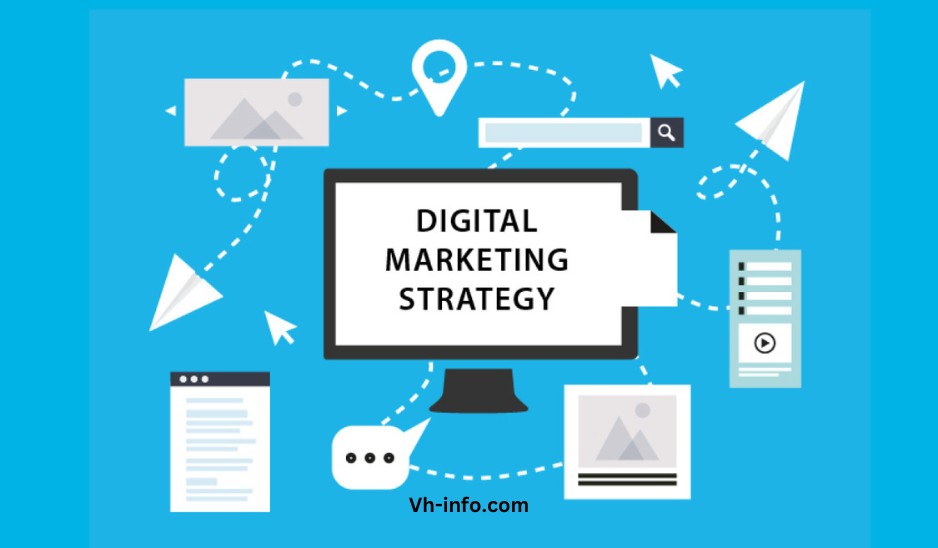
A digital marketing strategy is a planned, integrated approach to reaching a company’s target audience through digital channels like search, social media, email, and websites.
It leverages data and marketing automation to understand customers and personalize engagement across platforms. An effective strategy sets goals and tactics for digital activities to attract customers, drive sales, and deliver ROI.
Essentially, a digital strategy brings a business’ messages and offerings to relevant online spaces to achieve marketing and business growth objectives. It requires understanding your audience, marketplace, competitive landscape and how to break through the digital noise.
How does Digital Marketing help Businesses reach their target audience?
Digital marketing allows businesses to use online platforms and tools to connect with their ideal customers.
By analyzing data, they can tailor content and ads to specific groups based on interests and browsing habits. This level of personalization helps grab the attention of potential customers.
Overall, digital marketing gives companies a more focused, measurable way to promote products and services to relevant audiences online.
Why is Digital Marketing more Cost-Effective than Traditional Marketing?
Digital marketing platforms like social media and search engines allow businesses to reach large audiences with very little spend. Tools are available to target specific groups based on data like interests and demographics.
Companies only pay when users actively engage with the content, like clicking on an ad. With print or TV ads, you pay upfront without guarantee anyone sees or acts on it.
Overall, digital marketing provides more accountable, optimized, and affordable options to connect with potential customers.
What Type of Business need Digital Marketing?
Digital marketing is crucial for any business that wants to reach modern audiences online.
This includes companies that sell products or services to consumers via ecommerce sites or apps. It’s also important for B2B companies that want to connect with other businesses through content marketing and social media.
Essentially any organization that wants to find new customers, connect with stakeholders, promote their brand, and grow revenue would benefit from some form of digital marketing strategy. This allows key messages and value propositions to be distributed on critical digital channels.
Is Digital Marketing Better for the Future?
Yes, digital marketing is essential for the future as more consumers shift their time and attention to online platforms and mobile devices.
Companies must have an online presence and strategy to connect with target audiences. Digital channels also allow for better tracking of engagement and sales data in order to optimize spending and results.
While traditional formats like TV, print and radio still have value, digital tactics continue to see rapid innovation and rising importance. Businesses that fail to keep up digitally will get left behind competitors who leverage these smarter tools and insights.
Overall, emerging digital marketing approaches are critical for brands to remain visible and successful.
Conclusion
To sum up, a well-defined and structured digital marketing process is crucial for businesses to achieve their goals and maximize their online presence.
By conducting thorough research, creating compelling content, promoting effectively, analyzing data, and optimizing strategies, businesses can drive targeted traffic, engage customers, and achieve higher conversions.
While having a digital marketing process is essential for all businesses, it is important to tailor the approach based on the specific needs of B2B and B2C markets.
Each market requires unique strategies to effectively reach and engage their target audience.
Furthermore, several successful digital marketing examples, such as Lego’s Rebuild the World campaign, Dove’s Reverse Selfie campaign, and Jennifer Lopez’s #InTheMorningChallenge, highlight the effectiveness of well-executed digital marketing strategies.
If you have any more questions about digital marketing or want to explore how it can benefit your business, feel free to check out our FAQ section or contact our team for personalized guidance.

